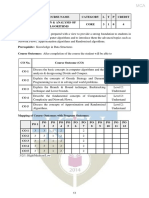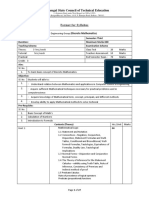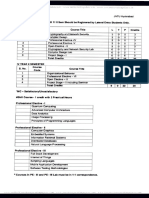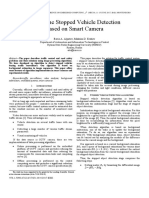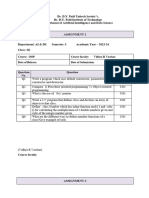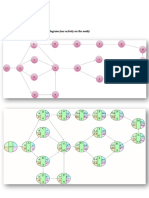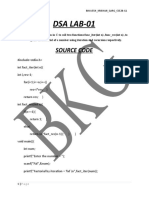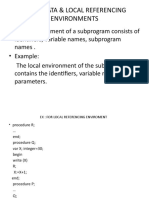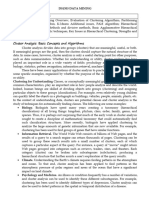DAA Questions and Objective
DAA Questions and Objective
Uploaded by
EslavathramdasCopyright:
Available Formats
DAA Questions and Objective
DAA Questions and Objective
Uploaded by
EslavathramdasCopyright
Available Formats
Share this document
Did you find this document useful?
Is this content inappropriate?
Copyright:
Available Formats
DAA Questions and Objective
DAA Questions and Objective
Uploaded by
EslavathramdasCopyright:
Available Formats
www.android.universityupdates.in | www.universityupdates.in | https://telegram.
me/jntuh
QUESTION BANK: (JNTUH)
Blooms
Course
S. No Question Taxonomy
Outcomes
Level
UNIT – I
PART – A (SHORT ANSWER QUESTIONS)
Define the term algorithm and state the criteria the algorithm
1 Knowledge 1
should satisfy.
2 Compute the average case time complexity of quick sort Apply 1
Describe the role of space complexity and time complexity of
3 Knowledge 1
a program?
4 If f(n)=5n2+ 6n + 4, then prove that f(n) is O(n2) Apply 4
What is meant by divide and conquer? Give the recurrence
5 Understand 1
relation for divide and conquer.
PART – B (LONGANSWER QUESTIONS)
1 Write binary search algorithm and analyze its time complexity Understand 1
Explain quick sort algorithm and simulate it for the following
2
data 20, 5,10,16 ,54 ,21 Apply 1
3 Illustrate merge sort algorithm and discuss time complexity Understand 2
4 Describe strassen’s matrix multiplication. Understand 2
Sort the list of numbers using merge sort: 78, 32, 42, 62, 98,
5
12, 34, 83 Apply 1
Blooms
Course
S. No Question Taxonomy
Outcomes
Level
UNIT – II
PART – A (SHORT ANSWER QUESTIONS)
1 Discuss about union operation on sets Knowledge 2
2 Describe AND/OR graph Understand 2
3 Explain game tree Understand 3
4 Define a connected and bi-connected component. Knowledge 2
5 Define an articulation point? Knowledge 2
PART – B (LONGANSWER QUESTIONS)
1 Discuss N-queens problem and algorithm Understand 2
Discuss about weighting rule for finding UNION of sets and
2
collapsing rule Understand 2
3 Differentiate divide and conquer and greedy method Understand 2
4 Discuss Graph coloring problem Understand 2
5 Compare and contrast BFS and DFS. Analyze 2
www.android.previousquestionpapers.com | www.previousquestionpapers.com | https://telegram.me/jntuh
www.android.universityupdates.in | www.universityupdates.in | https://telegram.me/jntuh
Blooms
Taxon Course
S. No Question
omy Outcomes
Level
UNIT – III
PART – A (SHORT ANSWER QUESTIONS)
1 Define greedy method Know edge 3
2 State Prim’s algorithm Knowledge 3
3 What is job sequencing with deadlines problem Know edge 3
4 State the principle of optimality Know edge 3
5 Define minimum cost spanning tree Know edge 3
PART – B (LONGANSWER QUESTIONS)
1 Discuss single source shortest path problem with example Apply 3
2 Discuss kruskal’s algorithm with an example Understand 3
3 Write an algorithm knapsack problem .Give example Apply 3
4 Explain prims algorithm with an example Understand 3
Compute the optimal solution for knapsack problem using
5 greedy method N=3,
M= 20, (p1,p2,p3)= (25,24,15), (w1,w2,w3) =(18,15,10) Apply 3
Blooms
Course
S.No Question Taxonomy
Outcomes
Level
UNIT – IV
PART – A (SHORT ANSWER QUESTIONS)
Write an algorithm for optimal binary search tree Give
1
example Apply 4
2 Explain 0/1 knapsack problem with example Understand 4
3 Discuss all pairs shortest path problem with an example Understand 4
Explain 8 – Queens
4
problem Understand 4
5 Define Sum of Subsets problem Understand 4
PART – B (LONGANSWER QUESTIONS)
Describe the travelling salesman problem and discuss
1
how to solve it using dynamic programming? Understand 4
2 Explain the concept Chained matrix multiplication. Apply 4
Solve the solution for 0/1 knapsack problem using
dynamic programming(p1,p2,p3, p4) = (11, 21, 31,
3
33), (w1, w2, w3, w4) = (2, 11, 22, 15), M=40, n=4
Apply 4
Use optimal binary search tree algorithm and
compute wij, cij, rij, 0<=i<=j<=4,p1=1/10, p2=1/5,
4 p3=1/10, p4=1/120, q0=1/5, q1=1/10, q2=1/5,
q3=1/20,q4=1/20.
Apply 3
www.android.previousquestionpapers.com | www.previousquestionpapers.com | https://telegram.me/jntuh
www.android.universityupdates.in | www.universityupdates.in | https://telegram.me/jntuh
5 Discuss all pairs shortest path problem with an example Understand 4
Blooms
Course
S.No Question Taxonomy
Outcomes
Level
UNIT – V
PART – A (SHORT ANSWER QUESTIONS)
1 Define a dead node Knowledge 5
2 Differentiate live node and dead node Knowledge 5
3 Compare NP-hard and NP-completeness Knowledge 5
4 Define deterministic problem Understand 5
5 Define maxclique problem? Understand 5
PART – B (LONG ANSWER QUESTIONS)
1 Explain the principle of FIFO branch and bound Apply 5
Explain the method of reduction to solve travelling sales
2
person problem using branch and bound Apply 5
3 Write non deterministic algorithm for sorting and searching Understand 5
What is chromatic number decision problem and clique
4
decision problem Apply 5
5 Explain Cook’s theorem Apply 5
X. OBJECTIVE QUESTIONS
MULTIPLE CHOICE QUESTIONS
UNIT-I
1. In analysis of algorithm, approximate relationship between the size of the job and the
amount of work required to do is expressed by using _________
(a) Central tendency (b) Differential equation (c) Order of execution (d) Order of magnitude
(e) Order of Storage.
Ans :Order of execution
2. Worst case efficiency of binary search is
(a) log2 n + 1 (b) n (c) N2 (d) 2n (e) log n.
Ans : log2 n + 1
3. For analyzing an algorithm, which is better computing time?
(a)O (100 Log N) (b) O (N) (c)O (2N) (d) O (N logN) (e) O (N2).
Ans :O (100 Log N)
4. Consider the usual algorithm for determining whether a sequence of parentheses is
balanced. What is the maximum number of parentheses that will appear on the stack AT
ANY ONE TIME when the algorithm analyzes: (()(())(()))
(a) 1 (b)2 (c)3 (d) 4
Ans :3
5. Breadth first search __________
(a) Scans each incident node along with its children. (b) Scans all incident edges before
moving to other node.(c) Issame as backtracking (d) Scans all the nodes in random order.
Ans :Scans all incident edges before moving to other node.
6. Which method of traversal does not use stack to hold nodes that are waiting to be
processed?
(a) Dept First (b) D-search (c)Breadth first (d) Back-tracking
www.android.previousquestionpapers.com | www.previousquestionpapers.com | https://telegram.me/jntuh
www.android.universityupdates.in | www.universityupdates.in | https://telegram.me/jntuh
Ans :Breadth first
7. The Knapsack problem where the objective function is to minimize the profit is______
(a) Greedy (b) Dynamic 0 / 1 (c) Back tracking (d) Branch & Bound 0/1
Ans :Branch& Bound 0/1
8. Choose the correct answer for the following statements:
I. The theory of NP–completeness provides a method of obtaining a polynomial time
for NPalgorithms.
II. All NP-complete problem are NP-Hard.
(a) I is FALSE and II is TRUE (b) I is TRUE and II is FALSE (c) Both are TRUE (d) Both
are FALSE
Ans :I is FALSE and II is TRUE
9. If all c(i, j )’s and r(i, j)’s are calculated, then OBST algorithm in worst case takes one of
the following time.
(a) O(n log n) (b) O(n3) (c) O(n2) (d) O(log n) (e) O(n4).
Ans : O(n3)
10. The upper bound on the time complexity of the nondeterministic sorting algorithm is
(a) O(n) (b) O(n log n) (c) O(1) (d) O( log n) (e) O(n2).
Ans: O(n)
UNIT-II
1. Name the node which has been generated but none of its children nodes have
been generated in state space tree of backtracking method.
(a) Dead node (b) Live node (c) E-Node (d) State Node
Ans: Livenode
2. How many nodes are there in a full state space tree with n = 6?
(a) 65 (b) 64 (c) 63 (d) 32
Ans : 63
3. This algorithm scans the list by swapping the entries whenever pair of adjacent keys are
out of desired order.
(a) Insertion sort. (b) Bubble sort. (c) Shell sort. (d) Quick sort.
Ans: Bubble sort.
4. From the following chose the one which belongs to the algorithm paradigm other than to
which others from the following belongs to.
(a) Minimum & Maximum problem. (b) Knapsack problem. (c) Selection problem.(d)
Merge sort.
Ans: Knapsack problem.
5. To calculatec(i, j )’s, w( i, j)’s and r(i, j)’s; the OBST algorithm in worst case takes the
following time.
(a) O(log n) (b) O (n4) (c) O (n3) (d) O (n log n)
Ans: O (n3)
6. What is the type of the algorithm used in solving the 4 Queens problem?
(a) Greedy (b) Dynamic (c) Branch and Bound (d) Backtracking.
Ans: Backtracking.
7.In Knapsack problem, the best strategy to get the optimal solution, where Pi, Wi is the
Profit, Weight associated with each of the Xi h object respectively is to
(a) Arrange the values Pi/Wi in ascending order (b) Arrange the values Pi/Xi in
ascending order
(c) Arrange the values Pi/Wi in descending order (d) Arrange the values Pi/Xi in
descending order
Ans: Arrange the values Pi/Xi in descending order
www.android.previousquestionpapers.com | www.previousquestionpapers.com | https://telegram.me/jntuh
www.android.universityupdates.in | www.universityupdates.in | https://telegram.me/jntuh
8.Greedy job scheduling with deadlines algorithms’ complexity is defined as
(a) O(N) (b) Ω( n log n) (c) O (n2 log n) (d) O ( n log n)
Ans: O(N)
9. From the following choose the one which belongs to the algorithm paradigm other than to
which others from the following belongs to.
(a) Minimum & Maximum problem (b) Knapsack problem (c) Selection problem (d) Merge
sort
Ans : Knapsack problem
UNIT-III
1. From the following pick the one which does not belongs to the same paradigm to which
others belongs to.
(a) Minimum & Maximum problem (b) Knapsack problem
(c) Selection problem (d) Merge sort
Ans:Knapsack problem
2. Primsalgorithm is based on _____________ method
a. Divide and conquer method c. Dynamic programming
b. Greedy method d. Branch and bound
Ans. Greedy Method
3. The amount of memory needs to run to completion is known as_____________
a. Space complexity c. Worst case
b. Time complexity d. Best case
Ans: Space complexity
4. The amount of time needs to run to completion is known as____________
a. Space complexity c. Worst case
b. Time complexity d. Best case
Ans: Time complexity
5. __________ is the minimum number of steps that can executed for the given parameters
a. Average case c. Worst case
b. Time complexity d. Best case
Ans: Best case
6. __________ is the maximum number of steps that can executed for the given parameters
a. Average case c. Worst case
b. Time complexity d. Best case
Ans:Worst case
7. __________ is the average number of steps that can executed for the given parameters
a. Average case c. Worst case
b. Time complexity d. Best case
Ans: Average Case
8. Testing of a program consists of 2 phases which are ______________________and
____________
a. Average case & Worst case b. Time complexity & Space complexity
c. Validation and checking errors d. Debugging and profiling
Ans: Debugging and profiling
9. Worst case time complexity of binary search is ______________
a. O(n) b. O(logn)c. Ɵ(nlogn) d. Ɵ(logn)
Ans: Ɵ(logn)
10. Best case time complexity of binary search is ______________
a. O(n) c. Ɵ(nlogn)b. O(logn) d. Ɵ(logn)
Ans: Ɵ(logn)
www.android.previousquestionpapers.com | www.previousquestionpapers.com | https://telegram.me/jntuh
www.android.universityupdates.in | www.universityupdates.in | https://telegram.me/jntuh
UNIT-IV
1. Tight bound is denoted as _______
a. Ω c. Θ
b. Ω d. O
Ans : Θ
2. Upper bound is denoted as _______
a. Ω c. Θ
b. ω d. O
Ans : O
3. lower bound is denoted as _______
a. Ω c. Θ
b. ω d. O
Ans :Ω
4. The function f(n)=o(g(n)) if and only if Limit f(n)/g(n)=0n->∞
a. Little oh b. Little omega
b. Big oh d. Omega
Ans : Little oh
5. The functionf(n)=o(g(n)) if and only if Limit g(n)/f(n)=0 n->∞
a. Little oh b. Little omega
b. Big oh d. Omega
Ans : Little omega
6. Thegeneralcriteriaofalgorithm;zero or more quantities are externally supplied is______
a. Output b. Finiteness
b. Effectiveness d. Input
Ans : Input
7. The general criteria of algorithm; at least one quantity is produced ______
a. Output b. Finiteness
b. Effectiveness d. Input
Ans : Output
8. The general criteria of algorithm; Each instruction is clear and unambiguous ______
a. Output b. Definiteness
b. Effectiveness d. Input
Ans : Definiteness
9. The general criteria of algorithm; algorithm must terminates after a finite number
of steps ______
a. Output b. Finiteness
b. Effectiveness d. Input
Ans : Finiteness
10. Which is not a criteria of algorithm
a. Input b. Output
b. Time complexity d. Best case
Ans : Best case
UNIT-V
1. job sequencing with deadline is based on ____________method
a. greedy method c. branch and bound
b. dynamic programming d. divide and conquer
Ans. Greedy method
2. fractional knapsack is based on ____________method
www.android.previousquestionpapers.com | www.previousquestionpapers.com | https://telegram.me/jntuh
www.android.universityupdates.in | www.universityupdates.in | https://telegram.me/jntuh
a. greedy method c. branch and bound
b. dynamic programming d. divide and conquer
Ans. Greedy method
3. 0/1 knapsack is based on ____________method
a. greedy method c. branch and bound
b. dynamic programming d. divide and conquer
Ans. Dynamic programming
4. The files x1,x2,x3 are 3 files of length 30,20,10 records each. What is the optimal
merge pattern value?
a. 110 c. 60
b. 90 d. 50
Ans. 90
5. The optimal merge pattern is based on _________ method
a. Greedy method b. Dynamic programming
c. Knapsack method d. Branch and bound
Ans. Greedy method
6. Who invented the word Algorithm
a. Abu Ja’far Mohammed ibn Musa c. Abu Mohammed Khan
b. Abu Jafar Mohammed Kasim d. Abu Ja’far Mohammed Ali Khan
Ans. Abu Ja’far Mohammed ibn Musa
7. In Algorithm comments begin with____________
a. /* c. /
b. */ d. //
Ans : //
8. The ___________ of an algorithm is the amount of memory it needs to run to
completion.
a. Space Complexity c. Best Case
b. Time Complexity d. Worst Case
Ans : Space Complexity
9. ___________ is the process of executing a correct program on data sets and
measuring the time and space it takes tocompute the results.
a. Debugging c. Combining
b. Profiling d. Conqure
Ans : Profiling
10. In Algorithm Specification the blockes are indicated with matching _______
a. Braces c. Square Brackets
b. Parenthesis d. Slashes
Ans : Braces
FILL IN THE BLANKS
UNIT-I
1. The worst case time complexity of the nondeterministic dynamic knapsack algorithm is
___
Ans :O(n)
2. Recursive algorithms are based on______________ approach
Ans :Bottom-up approach
3. What do you call the selected keys in the quick sort method_____________
Ans : Pivot key
4. How do you determine the cost of a spanning tree?
www.android.previousquestionpapers.com | www.previousquestionpapers.com | https://telegram.me/jntuh
www.android.universityupdates.in | www.universityupdates.in | https://telegram.me/jntuh
Ans :By the sum of the costs of the edges of the tree8.
5. The time complexity of the normal quick sort, randomized quick sort algorithms in the
worst case is ______________
Ans :O(n2), O(n2)
6. Let there be an array of length ‘N’, and the selection sort algorithm is used to sort it, how
many times a swap function is called to complete the execution?
Ans :N-1 times
7. The Sorting methodwhich is used for external sort is _________________
Ans :Radix sort
8. The graph colouringalgorithm’s time can be bounded by _________
Ans :O(nmn).
9. Sorting is not possible by using ____________ methods?
(a) Insertion (b) Selection (c) Deletion (d) Exchange
Ans :Deletion
10. What is the type of the algorithm used in solving the 8 Queens problem?
Ans :Backtracking
UNIT-II
1. Identify the name of the sorting in which time is not proportional to n2.
(a) Selection sort (b) Bubble sort (c) Quick sort (d) Insertion sort.
Ans : Insertion sort
2. The optimal solution to a problem is a combination of optimal solutions to its
subproblems. This is known as
. Ans : Principle of Optimality
3. Which of the following versions of merge sort algorithm does use space efficiently?
(a) Contiguous version (b) Array version (c) Linked version (d) Structure
version (e) Heap version.
Ans : Linked version
4. Identify the correct problem for multistage graph from the list given below.
(a) Resource allocation problem (b) Traveling salesperson problem
(c) Producer consumer problem (d) Barber’s problem
Ans : Resource allocation problem
5. How many edges are there in a Hamiltonian cycle if the edge cost is ‘c’ and the cost of
cycle is ‘cn’
Ans :n.
6. A problem L is NP-complete iff L is NP-hard and
Ans : L ε NP
7. What would be the cost value for any answering node of a sub tree with root ‘r’ using
branch-bound algorithm?
Ans: Minimum
UNIT-III
1. Average case time complexity of binary search is ______________
Ans: Ɵ(logn)
2. Merge sort invented by _____________
Ans : JOHN VON NEUMANN
3. Quick sort invented by _____________
Ans : CARHOARE
4. Worst case time complexity of Quick sort is ______________
Ans : O(n2)
www.android.previousquestionpapers.com | www.previousquestionpapers.com | https://telegram.me/jntuh
www.android.universityupdates.in | www.universityupdates.in | https://telegram.me/jntuh
5. Best case time complexity of Quick sort is ______________
Ans : O(nlogn)
6. Average case time complexity of Quick sort is ______________
Ans : O(nlogn)
7. Which design strategy stops theexecution when it find the solution otherwise starts the
problem from top
Ans: Back Tracking
8. Graphical representation of algorithm is _____________________
Ans: Flow Chart
9. In pseudo-code conventions input express as __________
Ans : Write
10. In pseudo-code conventions output express as __________
Ans : Read
UNIT-IV
1. Which is not in general criteria of algorithm
a. Input b. Output
b. Time complexity d. Effectiveness
Ans : Time complexity
2. Time complexity of given algorithm is ________________
Algorithm Display(A)
{
S:=0.0;
For i:=0 to n-1
{
S:=S+A[i];
Return S;
}
}
Ans : 4n+4
3. Time complexity of given algorithm
AlgorithmSum(A,S)
{
for i:=1 to n-1
{
for j:=2 to n-1
{
S:=S+i+j;
return S;
}
}
}
Ans :6n2-14n+10
4. kruskal algorithm is based on ___________method
Ans. Greedy method
5. Prims algorithm is based on _____________ method
Ans. Greedy Method
6. The output of Kruskal and Prims algorithm is ________________
Minimum cost spanning tree
www.android.previousquestionpapers.com | www.previousquestionpapers.com | https://telegram.me/jntuh
www.android.universityupdates.in | www.universityupdates.in | https://telegram.me/jntuh
UNIT-V
1. Huffmancodes are the applications of _________ with minimal weighted external
path length obtained by an optimal set.
Ans : Binary tree
2. From the following which is not return optimal solution
a. Dynamic programming c. Backtracking
b. Branch and bound d. Greedy method
Ans. Backtracking
3. ____________ is an algorithm design method that can be used when the solution
to a problem can be viewed as the result of a sequence of decisions
Ans : Dynamic programming
4. The name backtrack was first coined by _________
Ans :D.H.Lehmer
5. The term ________ refers to all state space search methods in which all hildren of the –
nodes are generated before any other live node can becomethe E-node.
Ans ; Branch and Bound
6. A __________ is a round trip path along n edges of G that visits every vertex once
and returns to its starting position.
Ans :Hamiltonian Cycle
7. Graph Coloring is __________ type of algorithm design strategy
Ans : Backtracking
8. Which of the following is not a limitation of binary search algorithm?
a. must use a sorted array
b. requirement of sorted array is expensive when a lot of insertion and deletions
are needed
c. there must be a mechanism to access middle element directly
d. binary search algorithm is not efficient when the data elements are more than 1000.
Ans : binary search algorithm is not efficient when the data elements are more than
1000.
9. Binary Search Algorithm cannot be applied to ___________________
Ans :Sorted linked list
10. Two main measures for the efficiency of an algorithm are
Ans : Time and Space
XI. GATE QUESTIONS:
1. The order of an internal node in a B+ tree index is the maximum number of children it can
have. Suppose that a child pointer takes 6 bytes, the search field value takes 14 bytes, and
the block size is 512 bytes. What is the order of the internal node?
A) 24B) 25C) 26D) 27
Answer : (C)
2 The best data structure to check whether an arithmetic expression has balanced parentheses
is a
A) queue B) stack C) tree D) list
Answer : (B)
3. A Priority-Queue is implemented as a Max-Heap. Initially, it has 5 elements. The level-
order traversal of the heap is given below: 10, 8,5,3,2 Two new elements 1 and 7 are
inserted in the heap in that order. The level-order traversal of the heap after the insertion of
the elements is
A) 10,8,7,5,3,2,1B) 10,8,7,2,3,1,5C) 10,8,7,1,2,3,5D) 10,8,7,3,2,1,5
Answer : (D)
www.android.previousquestionpapers.com | www.previousquestionpapers.com | https://telegram.me/jntuh
www.android.universityupdates.in | www.universityupdates.in | https://telegram.me/jntuh
4 The following numbers are inserted into an empty binary search tree in the given order:
10, 1, 3, 5, 15, 12, 16. What is the height of the binary search tree (the height is the
maximum distance of a leaf node from the root)?
A) 2B) 3C) 4D) 6
Answer : (B)
5 The goal of structured programming is to
A) have well indented programs B) be able to infer the flow of control from the compiled
Code C) be able to infer the flow of control from the program text D) avoid the use of GOTO
statements
Answer : (C)
6 The tightest lower bound on the number of comparisons, in the worst ease, for
comparison-based sorting is of the order of
A) nB) n 2C) n log n D) n log2 n
Answer : (B)
7 Let G be a simple graph with 20 vertices and 100 edges. The size of the minimum vertex
cover of G is 8. Then, the size of the maximum independent set of G is
A) 12 B) 8 C) Less than 8 D) More than 12
Answer : (A)
8 Let A be a sequence of 8 distinct integers sorted in ascending order. How many distinct
pairs of sequences, B and C are there such that (i) each is sorted in ascending order, (ii) B
has 5 and C has 3 elements, and (iii) the result of merging B and C gives A?
A) 2B) 30C) 56D) 256
Answer : (D)
9 A Priority-Queue is implemented as a Max-Heap. Initially, it has 5 elements. The level-
order traversal of the heap is given below: 10, 8,5,3,2 Two new elements 1 and 7 are
inserted in the heap in that order. The level-order traversal of the heap after the insertion of
the elements is
A) 10,8,7,5,3,2,1B) 10,8,7,2,3,1,5C) 10,8,7,1,2,3,5D) 10,8,7,3,2,1,5
Answer : (D)
10 The S-N curve for steel becomes asymptotic nearly at
A) 103 cycles B) 104cyclesC) 10 6 cycles D) 10 9 cycles
Answer : (C)
www.android.previousquestionpapers.com | www.previousquestionpapers.com | https://telegram.me/jntuh
You might also like
- Lecture Plan CALCULUS S18exam-Questions-QDocument6 pagesLecture Plan CALCULUS S18exam-Questions-QAhmed HassanNo ratings yet
- Fem Assignment Question Bank Unit 1&2 PDFDocument1 pageFem Assignment Question Bank Unit 1&2 PDFSudhakar UppalapatiNo ratings yet
- Applied MathematicsDocument4 pagesApplied MathematicsKamalnath GNo ratings yet
- Adsaa Cse Mid-2Document2 pagesAdsaa Cse Mid-2Srinivasan Nagaraj NNo ratings yet
- PPS Que Bank1Document6 pagesPPS Que Bank1M VINOD KUMARNo ratings yet
- GED Math Lessons Practice Problems Workbook (PDFDrive)Document357 pagesGED Math Lessons Practice Problems Workbook (PDFDrive)Guo QiangNo ratings yet
- GED Math Lessons Practice Problems Workbook SAMPLEDocument29 pagesGED Math Lessons Practice Problems Workbook SAMPLESam fryNo ratings yet
- DAA Question BankDocument9 pagesDAA Question BankTejasvi QueenyNo ratings yet
- 641501engineering Math-1 Lesson PlanDocument5 pages641501engineering Math-1 Lesson PlanShaktiprakashforever M2No ratings yet
- Silibus MAT455 - Sept15-Jan16Document4 pagesSilibus MAT455 - Sept15-Jan16Imran37AfiqNo ratings yet
- 50 Mathematics MinorDocument12 pages50 Mathematics MinorSrinu VasaraoNo ratings yet
- Mca2 Assigment 22 23Document20 pagesMca2 Assigment 22 23NagamaniNo ratings yet
- MS-108 Linear Algebra CIS Updated-2Document5 pagesMS-108 Linear Algebra CIS Updated-2Muhammad FaisalNo ratings yet
- DAA - QuestionBank - CSITDocument6 pagesDAA - QuestionBank - CSITMamata swainNo ratings yet
- Bits f464 Machine Learning - HandoutDocument2 pagesBits f464 Machine Learning - Handout10dspchemistryNo ratings yet
- Module M3.3 Demoivre's Theorem and Complex AlgebraDocument57 pagesModule M3.3 Demoivre's Theorem and Complex AlgebrabinodeNo ratings yet
- Adsaa DS Mid-2Document2 pagesAdsaa DS Mid-2Srinivasan Nagaraj NNo ratings yet
- ADA Unit 2 AssignmentDocument3 pagesADA Unit 2 Assignmentjaeson.terenceNo ratings yet
- 2.1 Communication Skills - IiDocument23 pages2.1 Communication Skills - IiArchNo ratings yet
- Engineering Math-IIIDocument5 pagesEngineering Math-IIITanveer MemonNo ratings yet
- Course Outline MAT 125.9 Summer2023Document6 pagesCourse Outline MAT 125.9 Summer2023Rubayet fahimNo ratings yet
- Course Outline MAT125 SPRING2024Document6 pagesCourse Outline MAT125 SPRING2024Safwan AbsarNo ratings yet
- Part - I: Gita Autonomous College, Bhubaneswar Question Bank Subject: Subject Code: BL CL O PO& Ps PsoDocument4 pagesPart - I: Gita Autonomous College, Bhubaneswar Question Bank Subject: Subject Code: BL CL O PO& Ps Psokumarloresh143No ratings yet
- 20MCA203 Design & Analysis of Algorithms Core 3 1 0 4: 3/2/1: High/Medium/LowDocument7 pages20MCA203 Design & Analysis of Algorithms Core 3 1 0 4: 3/2/1: High/Medium/LowNAJIYA NAZRIN P NNo ratings yet
- 20MCA203 Design & Analysis of Algorithms Core 3 1 0 4: 3/2/1: High/Medium/LowDocument7 pages20MCA203 Design & Analysis of Algorithms Core 3 1 0 4: 3/2/1: High/Medium/LowNAJIYA NAZRIN P NNo ratings yet
- 20MCA203 Design & Analysis of Algorithms Core 3 1 0 4: 3/2/1: High/Medium/LowDocument7 pages20MCA203 Design & Analysis of Algorithms Core 3 1 0 4: 3/2/1: High/Medium/LowNAJIYA NAZRIN P NNo ratings yet
- Data Tructure B. TECH 2ND SESSIONAL PAPER FORMATDocument2 pagesData Tructure B. TECH 2ND SESSIONAL PAPER FORMATsujeet singhNo ratings yet
- CS G526-HandoutDocument3 pagesCS G526-Handoutxedale7959No ratings yet
- 2.1 Communication Skills - Ii: RationaleDocument24 pages2.1 Communication Skills - Ii: RationaleChetan GuliaNo ratings yet
- Course Outline Sesi 1 2324Document4 pagesCourse Outline Sesi 1 2324mynameishaikal2604No ratings yet
- ML 2023 FinalExamDocument3 pagesML 2023 FinalExamPattranit TeerakosonNo ratings yet
- Sem II - Complex AnalysisDocument8 pagesSem II - Complex AnalysisPRIYANKA SAHUNo ratings yet
- Discrete Structures CLS's and PLO's With Weekly Course ContentsDocument6 pagesDiscrete Structures CLS's and PLO's With Weekly Course ContentsHayat Ullah100% (1)
- KTU MCA SyllabusDocument222 pagesKTU MCA SyllabusNajiya NajiNo ratings yet
- Adsa Assignment QuestionsDocument4 pagesAdsa Assignment QuestionsLOKESWARI GNo ratings yet
- 6sem Mid Sem PyqDocument7 pages6sem Mid Sem PyqSahil KhanNo ratings yet
- IGNOU MCA - NEW SyllabusDocument39 pagesIGNOU MCA - NEW SyllabusAnmol ThakurNo ratings yet
- B1 - probability theory 1Document5 pagesB1 - probability theory 1Nandakumar MeledamNo ratings yet
- Tutorial Sheet of Computer Algorithms (BCA)Document3 pagesTutorial Sheet of Computer Algorithms (BCA)xiayoNo ratings yet
- Maths IsoDocument31 pagesMaths Isogolamjay118No ratings yet
- DAA Unit-4 Course MaterialDocument28 pagesDAA Unit-4 Course MaterialPriya KolaparthyNo ratings yet
- Course-Outline MATH-111 EEE 1-I FALL2023Document7 pagesCourse-Outline MATH-111 EEE 1-I FALL2023ghumashe9No ratings yet
- Final TOC - Tutorial - 1 - 2Document15 pagesFinal TOC - Tutorial - 1 - 2Meet RavalNo ratings yet
- Semester I: Discipline: Electronics and Communication Stream: EC3Document99 pagesSemester I: Discipline: Electronics and Communication Stream: EC3Jerrin Thomas PanachakelNo ratings yet
- MATHEMATICS Minor SyllabusDocument49 pagesMATHEMATICS Minor SyllabusanushafiNo ratings yet
- Module M2.4 Introducing Scalars and Vectors: Flexible Learning Approach To PhysicsDocument56 pagesModule M2.4 Introducing Scalars and Vectors: Flexible Learning Approach To PhysicsGizachew BalchaNo ratings yet
- S1 EC5-SyllabusDocument104 pagesS1 EC5-SyllabusDr. Jayanthi V.S.No ratings yet
- MathsDocument110 pagesMathsDr PROF Ing GURUDUTT SAHNINo ratings yet
- Math F231 Number Theory - HandoutDocument3 pagesMath F231 Number Theory - HandoutGround zeroNo ratings yet
- Probability & StatisticsDocument8 pagesProbability & StatisticsA Raghava Chowdary maddipatiNo ratings yet
- SPM Add Math PresentationDocument31 pagesSPM Add Math PresentationDin Ika100% (4)
- P & S Important QuestionsDocument8 pagesP & S Important QuestionsSunil Choudhary100% (1)
- CSCI 665 Final - Any of The Objectives Can Be Tested On Your Final ExaminationDocument2 pagesCSCI 665 Final - Any of The Objectives Can Be Tested On Your Final ExaminationddkkNo ratings yet
- MAT125 OBE Based BisemisterDocument7 pagesMAT125 OBE Based BisemisterMaisha MeherinNo ratings yet
- MCA R S1 S2 - Compressed - Compressed Min 1 1Document159 pagesMCA R S1 S2 - Compressed - Compressed Min 1 1NamithaNo ratings yet
- LEARNING PLAN Lesson 2 PTDocument6 pagesLEARNING PLAN Lesson 2 PTErlinda Lingayo-EstradaNo ratings yet
- Unit 3Document10 pagesUnit 3xoxina7452No ratings yet
- 3rd Sem - 3 - Computer Science and Technology PDFDocument27 pages3rd Sem - 3 - Computer Science and Technology PDFPalash SamantaNo ratings yet
- Theory of ComputationDocument145 pagesTheory of ComputationM KISHORE,CSE(19-23) Vel Tech, ChennaiNo ratings yet
- ThreeDocument1 pageThreeEslavathramdasNo ratings yet
- PDF 1Document1 pagePDF 1EslavathramdasNo ratings yet
- DM Recorded ClassesDocument6 pagesDM Recorded ClassesEslavathramdasNo ratings yet
- Services of Transport LayerDocument41 pagesServices of Transport LayerEslavathramdasNo ratings yet
- Introduction To New ChapterDocument17 pagesIntroduction To New ChapterEslavathramdasNo ratings yet
- Tutorial 6Document11 pagesTutorial 6aryaman kushwahaNo ratings yet
- Real-Time Stopped Vehicle DetectionDocument4 pagesReal-Time Stopped Vehicle DetectionRudrani MondalNo ratings yet
- Module-1: Metrics and MeasuresDocument47 pagesModule-1: Metrics and MeasuresBharath N ReddyNo ratings yet
- Looking For A Challenge 2 enDocument27 pagesLooking For A Challenge 2 enZaidNo ratings yet
- C LECTURE NOTES Chapter 2Document12 pagesC LECTURE NOTES Chapter 2Vishal SinghNo ratings yet
- Unit-I: Introduction To Compilers Programming LanguagesDocument16 pagesUnit-I: Introduction To Compilers Programming LanguagesMR. HARSH DHURVENo ratings yet
- Xii - Ip - Holiday HWDocument2 pagesXii - Ip - Holiday HWVedika VishwakarmaNo ratings yet
- Ex - No: 1 Implementaion of Lexical Analyser-Token Separation DateDocument50 pagesEx - No: 1 Implementaion of Lexical Analyser-Token Separation Datesamjene90No ratings yet
- Python FileDocument23 pagesPython FileAnubhav ShailNo ratings yet
- OOP Assignment 1Document6 pagesOOP Assignment 1Prathamesh PatilNo ratings yet
- ISC Computer Science3Document5 pagesISC Computer Science3Dhruvi MittalNo ratings yet
- Waiting-Time SimulationDocument6 pagesWaiting-Time SimulationMuhammad FajarNo ratings yet
- Network DiagramDocument4 pagesNetwork DiagramRocio Isabel LuzuriagaNo ratings yet
- Spring 2022 - CS402 - 1Document2 pagesSpring 2022 - CS402 - 1Saman panjwaniNo ratings yet
- Bhavesh Krishan Garg Cse2b-G1 (Lab01)Document8 pagesBhavesh Krishan Garg Cse2b-G1 (Lab01)Bhavesh GargNo ratings yet
- Jimma University Course OutlineDocument1 pageJimma University Course OutlineCHARA100% (1)
- Practice DSA Problems ETDocument27 pagesPractice DSA Problems ETumarfarooque869No ratings yet
- Python Qazaqsha Sabak 1Document15 pagesPython Qazaqsha Sabak 1Damir MuratbaevNo ratings yet
- AS400 C++ Language ReferenceDocument481 pagesAS400 C++ Language Referencepinaksaha2010No ratings yet
- Local Data & Local Referencing EnvironmentsDocument15 pagesLocal Data & Local Referencing EnvironmentsSimin ThekootNo ratings yet
- TCS NQT Real Interview ExperenicesDocument19 pagesTCS NQT Real Interview ExperenicesAnurudra YadavNo ratings yet
- PHP Fundamentals Cheat Sheet: by ViaDocument1 pagePHP Fundamentals Cheat Sheet: by ViarofobinNo ratings yet
- Learning Exercise 6 - Measures of Central Tendency - grouped-TAMPOS, RAJDocument2 pagesLearning Exercise 6 - Measures of Central Tendency - grouped-TAMPOS, RAJrajtamposNo ratings yet
- Python CSV FilesDocument9 pagesPython CSV FilesVinod SrivastavaNo ratings yet
- Bca 13Document3 pagesBca 13Ts BoxNo ratings yet
- Developing Intelligent and Immutable Vaccine Supply and Operation Platform Using Blockchain and Artificial Intelligence TechnologiesDocument13 pagesDeveloping Intelligent and Immutable Vaccine Supply and Operation Platform Using Blockchain and Artificial Intelligence Technologiesthanhafathima480No ratings yet
- Fake Profile Detection in Social Media Using NLP: About The ProjectDocument33 pagesFake Profile Detection in Social Media Using NLP: About The Projectrajesh mech100% (1)
- Excel To DesktopDocument6 pagesExcel To DesktopMark WysorNo ratings yet
- Unit 4Document23 pagesUnit 4thalithatanusreeNo ratings yet
- Dsa Assignment: Name - Sanchit Namdeo Roll No. - 211020443 Branch - DSAIDocument23 pagesDsa Assignment: Name - Sanchit Namdeo Roll No. - 211020443 Branch - DSAIRavil PatelNo ratings yet

























